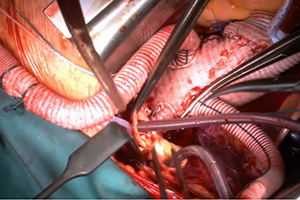Aortic arch replacement with frozen elephant trunk—when not to use it
Abstract
Current scientific evidence suggests the frozen elephant trunk (FET) technique plays an important role in modern aortic arch repair operations, both for aneurysmal disease and acute aortic dissection. Its use in extended aneurysm is generally therapeutic, aiming for complete exclusion of the diseased descending thoracic aorta. In acute aortic dissection type A, the application of FET is more prophylactic in nature, with the aim of preventing late dilatation of the proximal descending thoracic aorta. This review will present the journey of the elephant trunk from its conception to the current available technology. By tracing the historical evolution of the FET technique and prosthesis development, we explore the challenges and limitations of evidence-based surgical research. We present data from our growing experience in aortic arch reconstruction, the results from our latest 27 patients undergoing the 4-branch FET indicating substantially reduced morbidity and mortality (0%) in this complex patient cohort.
Cover






